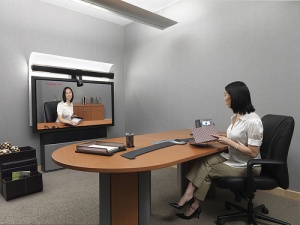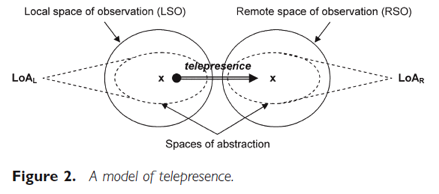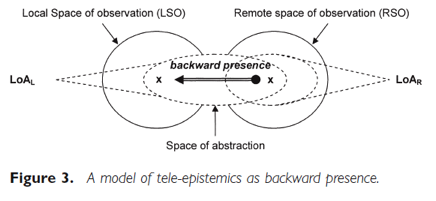Telepresence
Telepresence, or presence, refers to a type of technology that allows the users of the technology to feel present when they are not physically there. The feeling of presence, or of being there, is often accomplished through stimuli.
Contents
Uses of Telepresence
Cisco Systems
Today, Cisco Systems is a major contributor of telepresence in their technological products. By implementing telepresence in businesses, it creates more efficient collaboration between employees. It allows people to connect all around the world, share content and ideas, create video recordings and events, consult and collaborate with experts, and deliver personalized services in an immersive, face-to-face environment.
Lombard and Ditton
The standard view of telepresence, as defined by Lombard and Ditton is as follows:
- Presence is reduced to a type of perception, for example visual perception, for example seeing some geographical shapes and colors
- The type of perception in (1) is then specified, cognitively, as a special kind of experience, namely a psychological, subjective, meaningful interpretation of the experience; for example, experiencing the above-mentioned colors and shapes as a specified type of environment, for example a valley on Mars.
- The special kind of experience in (2) is further qualified, semantically, as a perception of contents that fails at least partially, momentarily, or occasionally, to be a perception of its machine-mediated nature as well, in out example, this means having the impression of being on Mars and failing to realize that it is actually a computer-mediated environment [1]
Floridi
Luciano Floridi presents a different view of telepresence, known as a successful observation. In Floridi's model of telepresence there are two different types of telepresence, forward and backward.
Forward Teleprsence
Forward telepresence happens when something goes from real life to the technology. This is known as action going from a local space of observation to a remote space of observation[2].
Examples
- Google Street View
- Police Scanners
- Remote Surgery
- Smart Cars
- Smart Houses
- Video Games
- Walkie-Talkies
Backward Telepresence
Backward telepresence happens when the technology draws the user into the technological world. This is known as action going from a remote space of observation to a local space of observation [1].
Examples
- Telethons: using phone to call television
- High Definition
- Video Games
Ethical Issues
Privacy
Concerning forward telepresence, protection of the observed’s privacy is protection of his (local or re-mote) space, whether physical, psychological, or informational [1].
Transparency
With telepresence, two world can be merged together, which brings up concerns of transparency and whether the barrier between real life and technology should exist or not.
See Also
References
- ↑ 1.0 1.1 1.2 Floridi, Luciano. The philosophy of presence: From epistemic failure to successful observation. Presence (Cambridge, Mass.) 14.6 01 Dec 2005: 656-667. MIT Press. 18 Dec 2011.
- ↑ Cite error: Invalid
<ref>tag; no text was provided for refs namedfloriri


